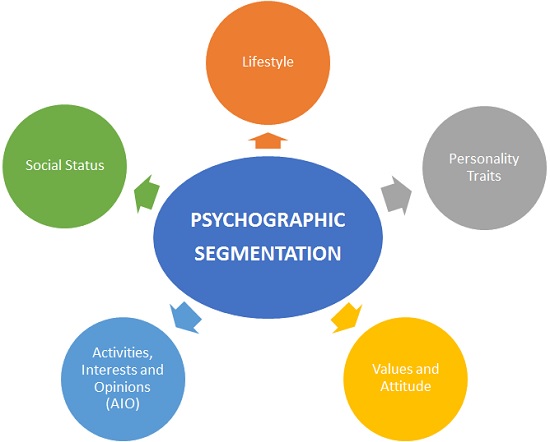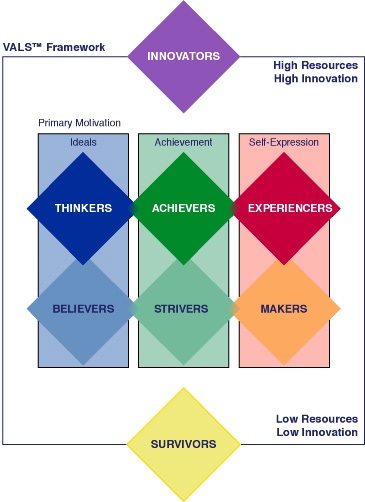Psychographic Segmentation

Psychographics is the science of using psychology and demographics to better understand consumers.
In psychographic segmentation, buyers are divided into groups on the basis of psychological/personality traits, lifestyle, or values.
People within the same demographic group can exhibit very different psychographic profiles.
One of the most popular commercially available classification systems based on psycho-graphic measurements is Strategic Business Insight’s (SBI) VALS™ framework.
VALS is based on psychological traits for people and classifies adults into eight primary groups based on responses to a questionnaire featuring four demographic and 35 attitudinal questions. The VALS system is continually updated with new data from more than 80,000 surveys per year (see Figure 6.1)

The main dimensions of the VALS framework are primary motivation (the horizontal dimension) and resources (the vertical dimension).
The vertical dimension segments people based on the degree to which they are innovative and have resources such as income, education, self-confidence, intelligence, leadership skills, and energy.
The horizontal dimension represents primary motivations and includes three distinct types:
- Consumers driven by knowledge and principles are motivated primarily by ideals. These consumers include groups called Thinkers en Believers.
- Consumers driven by demonstrating success to their peers are motivated primarily by achievement. These consumers include groups referred to as Achievers en Strivers.
- Consumers driven by a desire for social or physical activity, variety, and risk taking are motivated primarily by self-expression. These consumers include the groups known as Experiencers en Makers.
Innovator. These consumers are on the leading edge of change, have the highest incomes, and such high self-esteem and abundant resources that they can indulge in any or all self-orientations. They are located above the rectangle. Image is important to them as an expression of taste, independence, and character. Their consumer choices are directed toward the “finer things in life.”
Thinkers. These consumers are the high-resource group of those who are motivated by ideals. They are mature, responsible, well-educated professionals. Their leisure activities center on their homes, but they are well informed about what goes on in the world and are open to new ideas and social change. They have high incomes but are practical consumers and rational decision makers.
Believers. These consumers are the low-resource group of those who are motivated by ideals. They are conservative and predictable consumers who favor local products and established brands. Their lives are centered on family, community, and the nation. They have modest incomes.
Achievers. These consumers are the high-resource group of those who are motivated by achievement. They are successful work-oriented people who get their satisfaction from their jobs and families. They are politically conservative and respect authority and the status quo. They favor established products and services that show off their success to their peers.
Strivers. These consumers are the low-resource group of those who are motivated by achievements. They have values very similar to achievers but have fewer economic, social, and psychological resources. Style is extremely important to them as they strive to emulate people they admire.
Experiencers. These consumers are the high-resource group of those who are motivated by self-expression. They are the youngest of all the segments, with a median age of 25. They have a lot of energy, which they pour into physical exercise and social activities. They are avid consumers, spending heavily on clothing, fast-foods, music, and other youthful favorites, with particular emphasis on new products and services.
Makers. These consumers are the low-resource group of those who are motivated by self-expression. They are practical people who value self-sufficiency. They are focused on the familiar-family, work, and physical recreation-and have little interest in the broader world. As consumers, they appreciate practical and functional products.
Now a thinker is someone who is motivated by ideals, and has a well- defined thought process. She takes informed decisions after a thorough research on the product, its features and functionality. She is conservative, practical and knowledgeable and has a high regard for institutions and authorities.
Marketing and selling a product to a Thinker would involve taking her through the buying process by assisting her at each stage of information search and evaluation of choices, in such a manner that information is readily available at every stage. The product could be anything from a can of juice to a television set or a car, but the strategy is the same. Provide all the information about the features, attributes and benefits and educate her on the benefits of the features rather than the feature itself. The thinker looks for comfort, durability and value in the products she purchases, so services and warranties are crucial. Also since they are governed by ideals a high emphasis is placed on quality, and compliance to standards and rules. In essence they are rationalists and not driven by emotions
The best example in this regard could be for a savings scheme or a product that ensures health for the family. The ads illustrates this : (click to watch the commercial in a new window)
Why that ad works?
Message: A thinker is motivated by ideals. The message of the ad resonates with this ideology of the thinker, as it talks about the importance of saving, regardless of the amount. The option of saving is conservative and practical and talks of value, just like the thinker desires.
Relationships: The father-son scene towards the end of the ad, is indicative of the concerns that a parent has for his child and how inculcating a savings mentality can go a long way in ensuring a secure future for the child. It makes every parent and individual give a serious thought to the management of their wealth.
Value: The value is high in terms of durability, practicality and consistency. This value proposition is conveyed effectively through the ad.

